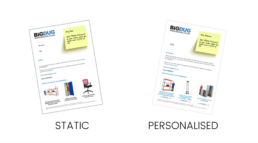Connecting with Consumers at Home in a Cookie-less World
Cookies are on the way out - Programmatic mail is in
It's no secret that third-party cookies are on the way out. With new regulations like the CCPA coming into effect along with regulation changes that occurred with GDPR, along with browsers like Safari and Firefox blocking third-party cookies by default, it's only a matter of time before they're a thing of the past.
But what does that mean for marketers? How can we connect with consumers if we can't track how they behave across a wider online ecosystem?
One solution is to focus on interactions on your specific website and first-party data. This is data that you collect yourself, through your own website or app. By collecting first-party data, you can build up a picture of your customers without relying on cookies.
Another solution is to move away from traditional online advertising and focus on more personalised, native forms of advertising. This could include content marketing, influencer marketing or even just good old-fashioned word-of-mouth marketing.
What's important is that you start thinking about how to connect with consumers in a cookieless world now, before it's too late.
Programmatic Direct Mail connects with consumers
Programmatic direct mail (PDM) is a type of marketing that uses technology to target and deliver personalized messages to consumers through the postal mail channel. It’s a way to connect with customers in a cookieless world, and it’s becoming increasingly popular as more companies adopt data-driven marketing strategies.
PDM allows marketers to send highly personalized and targeted messages to consumers without needing third-party cookies or other tracking data. This is because PDM purely relies on scripts placed directly on your client websites, such as purchase history and demographic information, to target consumers.
This type of marketing is especially effective in reaching consumers who have recently browsed and abandoned, or who are difficult to target with cookies. PDM can be used to supplement other online advertising campaigns and reach consumers who may have been exposed to your ads but didn’t click on them.
If you’re looking for a way to connect with consumers in a third-party cookieless world, PDM may be the right solution for you. Why follow your customers across the web when you can hit them up with a well-tailored and personalized mail piece landing at home to get the job done?

Three ways to make the most of Programmatic Direct Mail
With the rise of ad blockers and concerns about data privacy, marketers are struggling to reach consumers at the time most relevant to generate a sale. But there is a solution: programmatic direct mail.
As we have outlined Programmatic direct mail allows you to target consumers with personalized messages and offers, without using third-party cookies or other tracking methods. Here are three ways to make the most of this powerful marketing tool:
- select the right Partner for Programmatic Direct Mail
As the world becomes increasingly digitised, companies are finding new and innovative ways to reach their target audiences. However, one thing remains constant: the importance of connecting with consumers on a personal level.
One way to do this is through Programmatic Direct Mail (PDM). PDM direct marketing uses data-driven targeting to send personalised messages to a wider consumer base.
The benefits of PDM are clear. By using data to target consumers, companies can ensure that their message is relevant and targeted to the right audience. Additionally, PDM allows companies to track and measure the results of their campaigns, so they can adjust their strategy as needed.
However, not all PDM partners are created equal. It’s important to select a partner that has a proven track record of success and that offers a robust set of features.
Some things to look for in a PDM partner include:
-A technology that integrates seamlessly with your existing marketing stack
-The ability to target consumers across channels (e.g., email, direct mail, social media)
-Detailed reporting and analytics ability
-A team of experts who can help you get the most out of the platform
‘Programmatic Direct Mail’ is quite a new niche channel, and this buzzword is often thrown around without true capabilities… therefore choosing the right partner is all about asking the right questions:
Is this more than just automation?
Machine learning algorithms train their models against real-time intent and transaction data in order to optimize towards what you want them to do. This makes Programmatic Direct Mail more effective than marketing automation, which relies on events that are not an indicator of intent, rather more so based on some time-based trigger or common belief on the best approach
What about the data?
Traditional direct mail did not have the same nimbleness Programmatic Direct Mail enjoys when it came to reaching the most relevant consumers. For example, Programmatic Direct Mail does not need demographic or household data to find the right consumers for your company.

How much support do you need?
Some top tips below for understanding how much support is required
- You need to think about how much time and effort you want to commit to operating on a particular platform or utilising a team that implements the campaign for you.
- Understand the importance of using performance as a metric
- Programmatic Direct Mail is still a relatively new channel and how you evaluate performance requires a different mindset.
- The way consumers interact with mail, ads, and social media is different. A digital performance channel has an instant impact on the viewer, but a direct mail campaign can last for days or weeks. This requires more time to develop as you work on your attribution window.
- From a direct mail perspective, if a company is looking to get more of their mailing into digital space with Programmatic Direct Mail, they won’t have to spend as much money upfront and rely on volume from the mailing. Rather, companies can use analytics to see what performs the best and optimises ongoing spending in those areas.
With Programmatic Direct Mail you don’t need to send as much to achieve even better performance. It’s more about actively monitoring and managing against your performance goals in the moment rather than relying on more spending to reach more people in the hopes of generating a result.
Keep in mind that marketing automation and AI is still new technology. You should ask industry experts and those managing the platforms running these programs to help you understand the best practices of a campaign.
Full Funnel Marketing
With Programmatic Direct Mail, you can not only retarget people on your website with marketing messages but also boost performance and sales throughout the customer lifecycle. And this strategy is made more effective when your data is taken from first-party sources.
For example, Paperplanes can identify your highest average order customers, and that data could form the starting point for modelling other audiences (lookalikes and act alike) for prospecting. You can also score that list by conversion potential so you can drive more efficient performance with less burnout from your customer list.
Your first-party data not only helps you engage with customers, it also helps improve their experiences across all parts of the customer lifecycle. With your data, you don’t have to keep receiving irrelevant emails or ads. A Programmatic Direct Mail partner will use your data to create block lists and filters to ensure that your customers only get relevant messages and promotions from you. If you focus on segmentation and offer personalized content, you can win back buyers who have lost interest in your brand.
You need to continually test new strategies in marketing. This is crucial because your customers will demand more from your business in the next couple of years. Marketing strategies such as email campaigns, chatbots, and live video chats are fine but direct mail allows maximum exposure in the household with limited competition for your customer's attention. If you optimize correctly you will have the benefit of making performance on the channel even stronger as you go.
If you want to learn more about PaperPlanes approach to Programmatic Direct Mail, contact us through the form below.
Nectar: Recovery rates | 25% up through direct mail
Nectar: Basket spends & Recovery rates success story
Context
Nectar sleep offers high quality mattress products for those wishing to get the best night's sleep. Their mission is to support sleep through offering customers a high quality product and impeccable customer service.
The company teamed up with Paperplanes and PSE as they were struggling to convert a greater proportion of customers through an already successful email retargeting strategy.
Action
Opportunities were scoped to identify customers who abandoned their basket before completing the purchase, encourage those that have made a purchase to buy more and reactivate those who have not returned in a long period.
Targeted customers were presented with relevant, personalized, physical media with specifically targeted products, and extra incentives to visit the site, which were carefully split tested.

Results
- Customers were 25% more likely to return to Nectar after mailing
- Average basket value for mailed group is 10% stronger than non-mail counterparts
- Incremental ROAS of £11 for every £1 spent across the pilot period

- Customers mailed regarding abandoned baskets stay 40% longer than their non–mail counterparts. And there is already some early evidence of increased engagement with mailed customers viewing 20% more pages
Testimonial
" Paperplanes innovative approach to direct mail stands out. They have essentially turned direct mail into a digital channel, with all the digital metrics that make attribution possible. Combining this with proactive account management and a keen eye for detail has them fast becoming one of my go-to partners".
What does direct mail mean to Gen-Z? | Direct mail 3 times more effective with younger generations
What does direct mail mean to Gen Z?
Is Gen Z always online?
Gen Z is slowly beginning to age and mature into adulthood and with that Gen Z will be the generation that spends a large portion of the money circulating in the economy within the next decade. As with the evolution of consumer habits marketing will always need to keep up hence organisations are slowly beginning or should be beginning to market their products in a more targeted way to Gen Z.
Our generation grew up much differently than others. We grew up with phones, television, tablets, and the internet all within an arm's reach from a young age. It is reported that more than 55% of Gen Z admit to using their smartphone 5+ hours a day. This should be emphasised by the fact that over 95% of the generation also has access to smartphones meaning more than half of the entire generation is spending more than 5 hours a day on their smartphones. Gen Z quite truly is “Changing the social landscape. Marketers better take note or they won’t keep up” - Planoly

Reaction and effect of direct mail
Gen Z is very accustomed to and comfortable with experiencing marketing virtually through social media and E-mail particularly due to our large online presence. Despite this only 17% of Gen Z claims to do online shopping through their phones further contributing to the downsides of E-mail and online marketing. Too much of Gen-Z a large portion of online marketing reminds us of the famous Einstein quote on madness.
“The definition of insanity is doing the same thing over and over again and expecting different results” - Albert Einstein
The reason for this is the sheer frequency and persistence of much online marketing. Bots, spam accounts and generic email newsletters all overwhelm a consumer and lead to them developing a negative outlook toward the organisation that is marketing to them. This is precisely why Direct Mail marketing is ideal for marketing to Gen-Z.
Direct and Personalised mail is something a fraction of Gen-Z experience. Whilst everyone with an E-mail address is receiving multiple personalised emails they still wouldn’t be gripping due to their frequency. The physical nature of direct mail was listed as the root cause of its efficiency according to a WARC study which took place across the UK from 2016-2020.
The psychology behind direct mail
Well, what’s so special about receiving marketing in a physical form? To Gen-Z receiving personalized direct mail is likely to be a slightly foreign or maybe just rare occurrence. To receive a physically tangible piece of mail that is personalised and sent to you is going to make a majority of Gen-Z feel special due to the novelty a new experience provides.
Novelty marketing has been around since the 1970s and was originally used by toothpaste manufacturers. These manufacturers would incrementally change their product to allow marketers to present said product with a new campaign and new USP on some occasions. The whole theory behind the effectiveness of novelty marketing is that new experiences are novelty.
By nature and due to our biological limitations novelty is always going to be something humans like and actively seek out. Novelty improves our ability to retain and absorb information much like moving to a new country or neighbourhood, sights, sounds and experiences can all feel very novel, slightly overwhelming and most important novel. This same idea can be applied to receiving direct and personalised mail for the first time. The experience will be memorable for someone in Gen-Z receiving their first personalised direct piece of mail. This would make them more likely to learn something about the organisation's marketing to them and then put that to memory. Hence, this leads to an overall more effective marketing strategy.

Conclusions
Direct mail marketing, much like other forms of marketing, has a different level of success depending on several factors. In this instance, that factor is a generational difference (age and technology). This is precisely why direct mail can be the most effective marketing strategy for marketing to Gen-Z. Due to the fact that Gen-Z has grown up with technology, e-mail and digital marketing from a young age, it has become a less effective medium for marketing. The magnitude of impact that something refreshing such as direct mail can have on a young Gen-Z mind is remarkable and proves why direct mail marketing can be very effective with younger generations.
Sources
https://99firms.com/blog/generation-z-statistics/#gref
https://blog.planoly.com/gen-z-characteristics-marketers-learn-from
https://buffer.com/resources/novelty-and-the-brain-how-to-learn-more-and-improve-your-memory/
Get in touch to learn how Direct Mail can be implemented as part of your marketing strategy to better connect with your clients & attain a higher response
Where does direct mail fall in place Today? | Personalisation: E-mail and Direct mail
Personalisation In E-mail & direct mail Marketing
What is personalisation in marketing?
Personality and Individuality are considered to be the building blocks upon which human life has developed from. Ancient Greek philosopher Plato developed his belief on Individualism which states:
“a person taking part in society attempts to learn and discover what his or her own interests are on a personal basis, without a presumed following of the interests of a societal structure”

The belief describes how every person views society and their environment differently, which leads to everyone having different wants and needs. Marketing very much draws inspiration from Plato’s thoughts and tries to utilise the very fact that every person is unique. The belief of Individualism is used to justify a form of marketing where every individual receives a slightly different marketing experience, which should be tailored to their needs and wants.
Why personalisation is important to marketing
Marketing has a simple goal in its essence, which is to sell a service or a product to a customer. Inevitably marketing has become a tool which can grow customer loyalty, build brand recognition and grow an organisation's status amongst other businesses. Due to all these applications for marketing organisations began trying to further improve their marketing to gain an edge over their competitors.
This led to marketing becoming personalised as marketing directors began to notice better return rates and more successful campaigns when personalising their marketing. Consumers responded better feeling as if their personal needs were being catered to better by organisations that had given them personalised marketing. This was done through mail, newsletters, brochures and other physical forms of communication.
Digital Marketing & Personalisation
In the modern day It’s not uncommon to receive an email that seems personal and thoughtful which includes details such as the name of the individual, their birthday and possibly suggestions and offers to purchase based on their recent searches. All large e-commerce retailers have adopted this method of marketing. Seeing what their customers placed in their baskets, searched for or bought recently helps large corporations generate personalised emails to their customers.
By being able to personalise the shopping experience for each customer e-commerce platforms are able to upsell their products and services, by directing the appropriate marketing to each customer. Cookies and data mining are two methods used to study consumer behaviour or patterns and to allow e-commerce platforms to gather basic information that the customer allows them to gather. This leads the consumer to experience a unique marketing and shopping experience which will be more enjoyed by them.
Duality of E-mail
Human interconnectivity has taken leaps and bounds in the past decade with email becoming the most common form of communication across the globe. With 4 billion users G-mail promises huge marketing opportunities.
 (Source for average daily emails sent)
(Source for average daily emails sent)
This however has had the adverse effect on marketing through email. With 105 billion emails being sent daily marketing becomes less effective as each email drowns out the previous. This has led to a decline in effectiveness of email marketing despite the steps taken to make digital marketing more personalised to each individual.
Where does Direct Mail fall into place?
With email marketing becoming less effective and more common, other channels of marketing have been becoming more effective. Methods that include but aren’t limited to physical in person advertising, social media marketing and direct mail. The effectiveness of these methods has increased due to the lack of saturation that they have had over the past years.
Direct mail marketing has the benefit of being underused on a large scale making every piece of direct mail more significant. Response rates to physical mail have been much higher than email response rates in the last few years. Marketing emails received a 3.1% click through rate in 2020, additionally direct mail has been shown to require 21% less cognitive effort to process as compared to email. The conclusion that can be further drawn from this is that direct mail is easier to process, making it more effective as consumers are more likely to take on the task of reading the mail.
Paperplanes’ direct mail offers the same high level of personalisation that is found in email marketing and putting that into physical mail. Taking into account the product suggestions, incentives (discounts & offers) and level of personalisation that email brings and combining it with the high response/return rate of direct mail leads to successful results. Particularly in customers who abandon their baskets online, customers who haven’t made a second purchase in a while or customers who were browsing digitally without making a purchase.
For any direct mail marketing inquires and and questions feel free to contact us. In the top right hand corner of your screen or if you scroll all the way down to find our contact information.
Sources
https://www.emerald.com/insight/content/doi/10.1108/JSM-04-2013-0083/full/html
Pact Coffee | Reactivated 4% of subscriptions through direct mail
The Context
PACT Coffee offers their customers a world class specialty coffee delivered to their front door. They use ethically sourced coffee and allow customers to tailor subscriptions suited towards them.
Following success working on the Welcome strategy PACT were keen to work with Paperplanes on other marketing automation journeys. Resurrection of non-subscribers as well as follow ups for those dropping out the store and subscription processes were identified as potential opportunities.
The action
Paperplanes worked closely with the CRM and Growth teams in PACT to understand where we could add the most value. We decided to introduce variable product recommendations based on what customers had browsed. We segmented creatives further to highlight whether a customer browsed machinery vs coffee and introduced other A/B tests to refine and optimize our approach based on the information captured across the site via our tech integration.

The result
Encouraging results with impressive growth opportunities across all new campaign strategies launched which has provided a firm foundation to improve even further.
- Abandoned Basket Subs bring 40% more customers back to PACT than the non mail control

- Cohorts viewing 10% more pages than comparative non-mail controls
![]()

- 4% of recently paused subscriptions successfully reactivated, meaning we were successful creating incremental subscriptions as well as recovering lapsed subscriptions.

Testimonial
“Working with Paperplanes helped us to reach our customers in new ways and has led us to achieve a greater level of lifetime value from the base.We hoped to see a stronger conversion through mailing and was happy to find a higher retention rate across mailed groups. Paperplanes has helped uncover insights on how we can use direct mail to target customers over a longer term.”
CRM, Pact Coffee
Myths about direct mail marketing: Debunked
Myths about direct mail marketing: Direct Mail is and will always be a timeless and long-lasting marketing tool, yet, in our digital era, many have started to doubt its effectiveness. Why? Because most digital forms of marketing are all we have ever been exposed to. Take into consideration, for example, that some consumers are receiving an average of 100 emails daily and the overutilisation of the channel becomes clear. On the other hand, Paperplanes’ mission is to combine the tangible with the digital, providing marketers with an opportunity to create content that stands out among all the emails consumers constantly receive and disregard. However, marketers can still forget about the power of tangible media and fall prey to misconceptions and myths about its ineffectiveness.
Here are some myths we have encountered about direct mail marketing.
 Myths about direct mail marketing: No one opens direct mail anymore
Myths about direct mail marketing: No one opens direct mail anymore
Fact: People love tangible mail because it engages all their five senses in the process of assimilation, makes them feel included, and is memorable compared to the standard mail. 90% of postal marketing is opened by the customers, compared to only 20% of digital mail. Thus why direct mail campaigns’ response rates are as high as 4.4% when delivered through standard mail and 25% for Paperplanes enhanced automation, compared to just 0.12% of online campaigns*.

Myths about direct mail marketing: Direct mail is not sustainable
Fact: Our idea of environmentally sustainable postal marketing stands on three pillars – 1) partnering with production partners with high environmental standards, 2) the ‘less is more' approach, and 3) data-driven efficiency. All of our print partners respect and hold certifications for high standards of sustainable production and manufacture. 'Less is more' means that customers do not need to be spammed with impersonal or irrelevant content. Data-driven marketing targets recipients who are actively showing interest in products at the right time and only follows up with them once to avoid any frustration or fatigue with the channel.
Check out our blog for more information about how our programmatic direct mail marketing strategy is sustainable: https://paperplanes.co.uk/can-direct-mail-be-environmentally-sustainable/

Myths about direct mail marketing: Direct mail lacks impact
Fact: Each piece of postal marketing is carefully curated and designed to give a visually impressive and interactive experience to customers. After all, subconsciously, we all crave something personalised and relevant to us, with the emotional effect playing an important role in direct mail's impact. As discovered by the UK Royal Mail, 60% of the recipients of direct mail said this effect made a more lasting mental impression on them, making it easier to recall later on, while 57% said that it makes them feel more valued and creates a more authentic relationship.
Final thoughts
One's job, as a marketer, is to optimise resources for obtaining outstanding results, so make sure you are not dismissing the traditional options based on misconceptions. It would be a pity to disregard the massive potential of programmatic direct mail based on a lack of knowledge. ‘In a sea of information, look out for the facts' and drop us an email to find out a little more.
Sources
https://earthweb.com/how-many-emails-does-the-average-person-receive-per-day/
https://www.lucidpress.com/blog/direct-mail-marketing-does-it-still-work
4 Reasons to Fall in Love with Direct Marketing
The digital era has amplified opportunities for marketers to reach consumers in real-time and with increasing personalisation, but with people receiving an average of 10,000 marketing messages daily*, it has also become increasingly difficult to stand out. The challenge is formulating a message that will cut through the noise and be recognised by your consumer but considering the saturation of the digital channel how do you achieve this goal? Following the crowd and investing most of your marketing budget into digital, will most likely not maximise the returns. So why not zig when everyone zags and consider more traditional forms of direct marketing such as direct mail?
Direct mail has many unique advantages that other marketing channels do not have. The opportunity to engage senses, especially the power of touch triggers an emotional reaction and a much higher engagement and recall rate than digital. Furthermore, Paperplanes takes a data-driven approach to mail, making use of the science behind it, tailoring the copy and creative to audience segments and analysing results along the way for consistent campaign optimisation. We can’t help falling in love with this new way of approaching direct mail and here are four other attractive traits which we think will make you head over heels.
Mail has a Higher Recall Rate
According to neuroscience research which measures the response of the subconscious brain to messages, direct mail activates areas of the brain responsible for long-term memory. This is crucial to marketers as messages which are stored for longer than one minute can influence purchase intent and inspire action. According to The Joint Industry Committee for Mail, 31% of all addressed marketing mail results in a commercial action. Furthermore, IPA Touchpoints reported that as a result of receiving mail, 37% of people bought or ordered something in the past 12 months.
This shows how direct mail, when incorporated into your marketing efforts can help increase brand recall and recognition, consequently, encouraging consumers to finalise purchase or further engage with the brand, leading to conversions and a high ROI. Compared to email, mail can trigger a 49% higher recall rate and 35% higher than social media advertising *.
The Five Senses
While most marketing techniques only engage the consumer’s sight, mail provides an immersive experience by engaging all of your senses but especially the sense of touch. This not only helps increase recall rates as mentioned before but grasps consumers undivided attention. The physical appeal of mail together with personalised messages, makes the consumer feel appreciated and valued while respecting their inbox space. Recent research by the Royal Mail on measuring mail’s effectiveness through neuroscience, claims that people are likely to give mail their 65% full attention compared to 35% for email marketing. Furthermore, 70% of people said that receiving mail gives them a better impression of the company.
Making consumer’s feel valued and recognised is key to re-marketing. The combination of physical media with personalisation can do exactly that. When working with Smartphoto, (pioneers of digitalised photos and personalised gift), we were able to outline firsthand that personalisation makes or breaks a campaign. Mail featuring the products and categories consumer’s had previously engaged with whilst browsing the website, generated a 350% uplift in conversion compared to a standard generic creative.
See more case studies here

Age is Just a Number
As an older form of marketing, mail is also traditionally associated with an older demographic, limiting perceived reach or effectiveness for targeting younger generations. However, this is just a myth as mail can make a lasting impression regardless of the age. Further research from Royal Mail showed that brain responses to mail for those over and under 35 had higher encoding and engagement responses than for social media advertising. The Life Stages of Mail study, also outlined that young adults living in shared accommodations were 75% more likely to buy or order something as a result of mail.
Effectively targeting millennials poses an ongoing challenge to marketers, and despite engagement on mobile and app-based technologies being high, this should not stop you from considering other options such as the post box. Millennials actually value real interactions with brands and as stated by Gallup, not only do 36% of people under 30 claim to look forward to reading their mail but 95% of 18 to 29-year-olds have a positive reaction to personalised mail*.
International cosmetics brand, Benefit, sees millennials as a key target demographic and saw a 60% uplift on featured products when working with us.

A Match Made in Heaven
Direct mail can be easily incorporated as part of your current digital marketing mix. When adding direct mail to their already advanced social media strategies, OTTY noted that browsers were 30% more likely to return to site after receiving mail. Integration and a multi-channel approach is key to a strong and steady marketing strategy. According to Royal Mail research, the time spent looking at social ads increased from an average of 3.3 seconds for those who had not seen mail to 4.3 seconds for people who had previously seen mail, spending 30% longer.
When planning out your marketing budget if you consider investing in direct mail together with your current digital efforts, it can significantly leverage engagement, conversions and response rate. By incorporating mail prior to online display, email and social media advertising, the consumer stands more chance of having your brand already encoded in their memory and will pay more attention to all forms of marketing, increasing intent of purchase and the engagement in consumption actions.

Final Thoughts
Although direct mail is an underrated channel by many marketers there are plenty of reasons to fall back in love with the channel. The four reasons outlined will hopefully make you reconsider it as an effective, memorable and non-intrusive marketing mechanic that can cut through the noise and get your brand noticed in a digitally-dominant world. Paired with your current marketing strategy, you’re guaranteed results. Contact us for a free demo or just to chat here.
*How To Cut Through The Noise And Connect With Customers, American Marketing Association, 2018.
*https://www.marketreach.co.uk/resources/measuring-mail-with-neuroscience
*https://www.marketreach.co.uk/sites/default/files/RM_MarketReach_Mail-Cuts-Through-Report_0.pdf
*https://www.uktech.news/how-to-market-to-millennials-20200131
Ready to talk personalised direct mail?
Glide a message into our inbox and a member of the Paperplanes team will be in touch.
BIGDUG: 50% uplift in conversion rate thanks to extra personalisation
When adding extra elements of personalisation in the mailings, BIGDUG saw a 30-75% sales performance uplift.
When adding extra elements of personalisation in the mailings, BIGDUG saw a 30-75% sales performance uplift.
The Context
BiGDUG offers everything from Shelving and Racking, to Workplace Products and Packing. They’re also known for offering the best quality storage and shelving products at the most competitive price with impeccable customer service. BiGDUG had already partnered with Paperplanes achieving good results by sending automated programmatic mail. They were interested to see if adding extra elements of personalisation to mail could help them achieve an increase in customer engagement online and in conversion rates.
The Action
BiGDUG, PSE and Paperplanes managed to implement personalisation using a machine learning algorithm. This was able to identify customers who had been browsing products on Big Dug’s website but hadn’t gone through with the purchase, and then make personalised recommendations.
The A/B test that was conducted compared non- personalised versus personalised mail results and was a pivotal point of the campaign, as it underlined the impact that personalisation can have on conversion rates.

The Results
The insights were impressive and confirmed the importance of personalisation.
- A 20% increase website traffic was registered as a result of added personalisation in A4 mailings
- 30-75% improved sales performance when personalisation was added
Even businesses’ performance increased as a result of personalisation
- The abandoned basket campaign that included personalisation registered a 10.3% conversion rate against the already strong 7% of the non-personalised
Testimonial
“Having already had a successful partnership with Paperplanes in place, we wanted to explore how adding extra personalisation to the mailings could help us achieve higher engagement and conversion rates.
The A/B test conducted made us understand how personalisation could make a difference and we saw some impressive results. No one would have expected an almost 50% uplift in conversion rate after the success of the first campaign, which was quite frankly astonishing.
Furthermore, thanks to the extra personalisation added in the mail we were able to register a 20% increase in website traffic.
As we sell to both B2B and B2C customers, we were really interested to see how Paperplanes were able to adapt our mail to suit both customer bases and their requirements and provide accurate and insightful reporting for both of these customer types.”
Head of Marketing, BiGDUG
No one would have expected an almost 50% uplift in conversion rate after the success of the first campaign, which was quite frankly astonishing.
Ready to talk personalised direct mail?
Glide a message into our inbox and a member of the Paperplanes team will be in touch.
LoveYourself: £18 to £1 Return on Investment
With the Help of Programmatic Direct Mail, LoveYourself saw a £18 to £1 Return on Investment
With the Help of Programmatic Direct Mail, LoveYourself saw a £18 to £1 Return on Investment
The Context
LoveYourself is one of the leading food subscription businesses which provides prepared healthy meals ready to eat.
The idea behind the brand is to take the hassles out of dieting, combining well rounded nutrition and diverse flavours.
Loveyourself was interested to see if the addition of direct mail to their marketing strategy could help them achieve long-term engagement, higher retention rates and greater levels of spend.
The Action
Paperplanes partnered with LoveYourself to work towards two strategies, firstly identifying customers who abandoned their baskets and secondly identifying customers who after an initial purchase did not come back for at least 8 months.
The machine learning alghorythm is able to identify these segments and to automatically trigger relevant and personalised mail directly to the customer’s address.
The creatives were tailored for each strategy with high levels of personalisation in both to drive customers back to the website.

The Results
The results were outstanding with a £18 to £1 ROAS (Return on Adv Spend) for the abandoned basket campaign and returns as high as ten times the marketing spend for the reactivation campaign.
Conversion rates for the abandoned basket were at 9.1% vs 0% of control with an average basket value of £182
The lapsers’ conversion rates reached a peak of 4.6% for those who haven’t been back for 8 months
Out of the total mailed universe for basket, 25% went onto make more than one follow on purchase (vs 0% in the control)
Testimonial
We were interested to see if a partnership with Paperplanes could help us increase conversion rates for those customers who abandoned their basket before check out and re-engage our lapsing customers.
Paperplanes were able to achieve a £18 to £1 ROAS for the abandoned basket strategy and a conversion rate of 9.1%; as well as valuable insights into spending patterns of different lapsed segments.
It is astonishing how in this digital era, physical mail is still able to bring great results, and remain an integral part of the overall strategy.
Sales Marketing Manager, LoveYourself
It is astonishing how in this digital era, physical mail is still able to bring great results, and remain an integral part of the overall strategy.
Ready to talk personalised direct mail?
Glide a message into our inbox and a member of the Paperplanes team will be in touch.
Can Direct Mail be environmentally sustainable?
Direct Mail sustainability
Direct mail has had had a reputation for being one of the least sustainable marketing channels. This wasn’t helped by the fact the channel has been used to reach high volumes of customers mostly for prospecting and acquisition. As a result, you can understand why a significant number of mail produced might not have even been opened and ended up in the bin, especially if whoever received it wasn’t interested in what it contained. An incredible amount of paper can be wasted if the intended audience deems marketing they receive as irrelevant. Add to this the fact that there has always been scrutiny around the carbon emissions generated when delivering mail leading many to believe that digital marketing is far more sustainable.
However today, things have changed regarding the approach to direct mail and if implemented and integrated properly into a marketing strategy it can be used efficiently to aid your strategy in an environmentally conscious fashion. This could be by cutting through the clutter of the infinite amount of promotional content that consumers face on social media feeds and emails, and more importantly, now marketers don’t have to choose between the effectiveness of direct mail and their commitment to sustainability. Thanks to our technology and expertise, Paperplanes can provide a more sustainable approach to multi-channel marketing, avoiding any waste through a meticulous process of targeting and personalisation.

Partners with high environmental standards
The first step in making direct mail sustainable is to find production partners that have high environmental standards in mind. Certifications such as ISO 14001 and the ability to gain FSC (Forest Stewardship Council) approval for materials provides confidence that sustainability is a key focus. Print production partners should have those accreditations in place and we are always looking for new innovations to limit the impact on the environment.
Customers should not be spammed
We always tell our clients that the key to high conversion rates and Return on Investment is not reaching the highest number of people, but to reach the right people at the right time. Furthermore, it is crucial to include elements of personalisation in the mailings. That way the customer feels that the company sending mail has put in a lot of time and effort into sending something the recipient cares about. This all results in less waste, decreased cost on postage and limited impact on the resources.
For example, if an individual who has not engaged with a company before receives a piece of mail, it is less likely that a commercial action will be taken from it. In most cases the mail will not be even opened as the customer does not have any connection to it. On the other hand Paperplanes technology targets the customers who have been browsing and buying on the company’s website, or that have been in contact with the website in the past and send personalised and relevant mail creating incentive to come back to the website. Carefully monitoring results on an ongoing basis then allow us to optimise and refine targeting even further, boosting conversions and pinpointing exactly how sending mail will drive the desired action.
Data drives efficiency
The last piece of the puzzle is to ensure data is used to identify the right recipients and ensure there isn’t too many communications reaching those people on a regular basis and removing any who do not want to receive in the future. Technology can be established to manage the number of contacts for any one individual and if customers do wish to no longer receive any post in the future they can be removed from mailing universes. Data shouldn’t just trigger a sales opportunity, it should be used to limit the amount of content sent in the post.
Final Thoughts
The direct mail channel can be the perfect ally for your digital marketing strategy and for the planet, but only if implemented in a sustainable way. At Paperplanes we believe that “Sending less is more” and through only targeting the right audience and reaching them at the right time can we ultimately generate a sustainable outcome and at the same time help you achieve great results. Through doing this we can ensure that mail will only boost anything achieved by initiating a digital strategy alone. The data speaks for itself, Paperplanes average conversion rate for our marketing automations register at 12% against the average email conversion rate that fluctuated between 1-3%.












